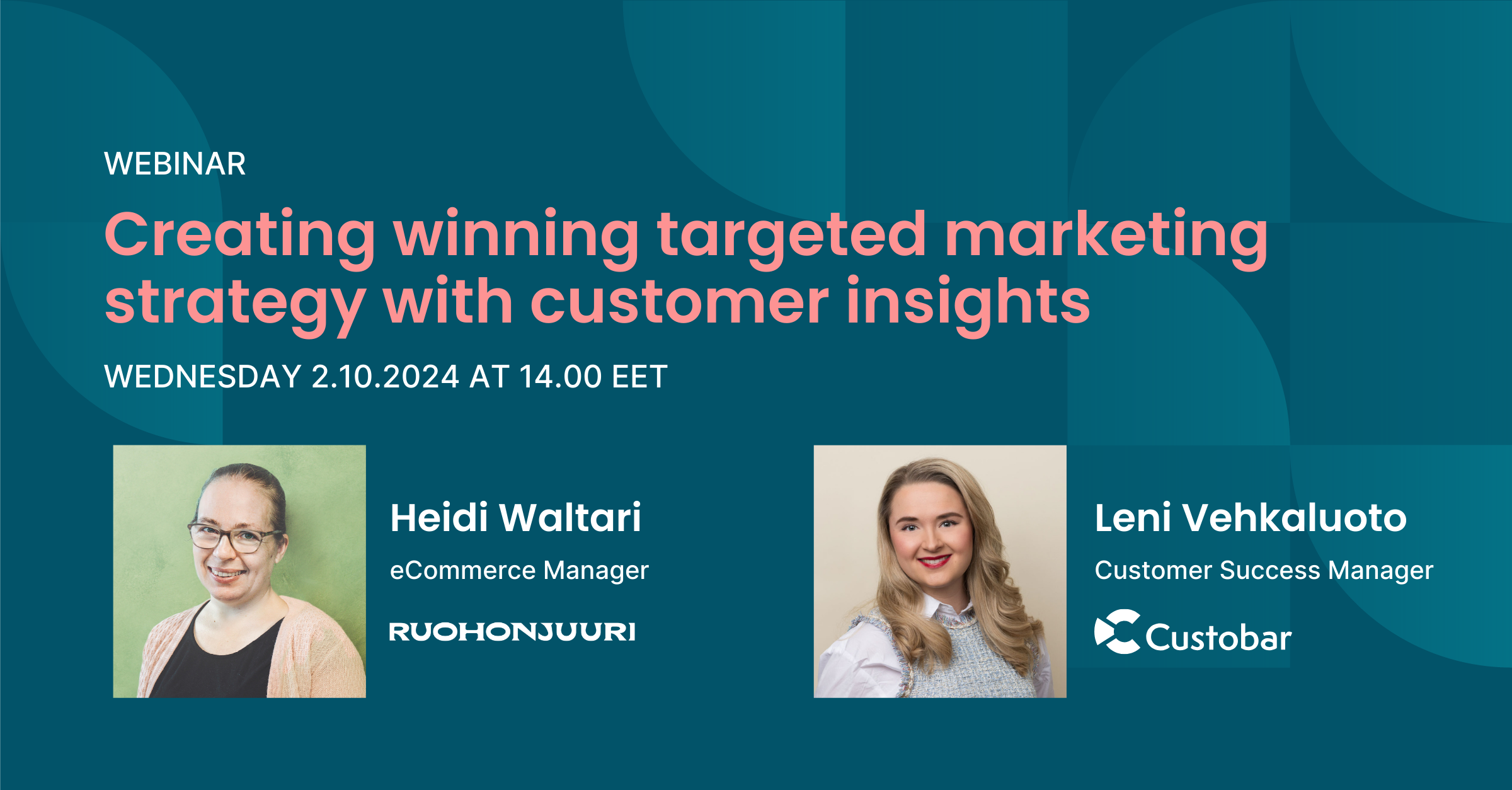
Creating winning targeted marketing strategy with customer insights
Are you ready to transform your marketing strategy? Watch an insightful webinar with Ruohonjuuri, tailored specifically for e-commerce and omnichannel retailers.

Are you ready to transform your marketing strategy? Watch an insightful webinar with Ruohonjuuri, tailored specifically for e-commerce and omnichannel retailers.

Custobar
20. September 2024
Black Friday and Cyber Monday create a significant increase in consumer demand. Retailers can provide appealing discounts and promotions to attract a larger market share and boost sales volume. As a result, these days provide retailers with a unique opportunity to expand their businesses and grow their customer base during a crucial time of the year.
Acquiring new customers during the peak season comes with increased costs. Advertising expenses rise significantly in November, and offering discounts also impacts costs. To fully utilise the potential of new customers and achieve long-term business growth, retailers need to create strategies to engage and retain them, thus avoiding unnecessary ad spending. Given that, on average, 55 % of online shoppers buy only once, activating Black Friday and Cyber Monday one-time buyers is even more challenging, as 79 % of them only buy once and never come back. There is good news, though! Once these customers have been activated to buy a second time, the likelihood of them making a third purchase and then, from a third to fourth purchase, increases significantly.*
Effective communication during their limited attention span is crucial to turning one-time bargain hunters into repeat customers. Retailers must find a way to engage them meaningfully. Choosing the right target audience is essential for generating sales and increasing customer retention.
Let's explore six tips for turning one-time Black Friday and Cyber Monday sales into recurring purchases to maximise the potential of newly acquired customers.
Retailers should use data from previous Black Friday sales to identify trends and customer preferences. By analysing which products were most popular, peak traffic times, and the most effective marketing channels for conversions, they can refine their strategies. Focusing on first-party data allows them to control customer information directly, bypassing third parties like Facebook. This approach is crucial in light of strict data protection regulations and privacy concerns.
Managing customer data in-house ensures compliance with privacy laws and helps maintain customer trust. Since first-party data is unique and cannot be replicated by competitors, it provides a competitive advantage by enabling a deeper understanding of customers. This insight allows retailers to customise their products, services, and marketing efforts to match their customers' needs and preferences, offering a tailored shopping experience.
Customer segments enable retailers to understand their customers better and create targeted marketing campaigns. By categorising customers based on their browsing and purchase histories, preferences, demographics, or behaviours, businesses can tailor their marketing messages and offers to appeal to specific customer groups.
Identifying the customer segment of first-time buyers during Black Friday and Cyber Monday allows retailers to focus their communication on this particular segment and effectively track campaign conversions.

Effective communication is crucial for building customer loyalty. Instead of sending generic messages, tailoring communication to customers' preferences will make them feel recognised and understood. This can help retailers establish a more robust customer connection, leading to repeat purchases.
Sending personalised messages, offers, and promotions to specific customer segments, such as Black Friday and Cyber Monday one-time buyers, can boost customer engagement and increase conversion rates. Businesses can strengthen their sense of belonging by treating customers individually and fostering long-term loyalty beyond single transactions.
Marketing automation is a game-changer for engaging one-time buyers. Following up with customers after their initial purchase is crucial for maintaining their interest and encouraging future transactions. Retailers can use marketing automation to set up automated email sequences or other communication channels to send timely and relevant messages such as order confirmations, shipping updates, product recommendations, and exclusive offers. This ensures that customers feel supported and valued.

Custobar's Flow allows retailers to easily create personalised, automated omnichannel messages.
Using multiple channels is essential to maximise the engagement of customers who make one-time purchases. While email automation is commonly used, retailers should not limit themselves to just one channel. Instead, they should consider using SMS, Google Ads, Meta, and other platforms to reach customers. SMS campaigns have been proven to be successful due to high conversion rates and lower competition. However, retailers must ensure that their messages are not spammy, regardless of the channel used, as customers have a low tolerance for excessive messages.
After customers make a purchase, it's beneficial to send them emails that guide them on how to make the most of their purchase and showcase related products or accessories. This approach can significantly increase the likelihood of customers making repeat purchases.
Following Black Friday, it's a good idea to send follow-up emails to thank customers for their purchases. These emails should include a discount code for their next order to encourage repeat purchases. Feedback on their shopping experience and a review can also be requested. Effective post-sale communication shows customers their business is valued and helps build a strong, long-term relationship.
*Analysis of customer data from 20 Finnish retailers with two million customers in all in 2022 conducted by Custobar.

We're pleased to announce several significant updates to the Custobar platform.

Turning passive customers into active ones is an essential strategy for any business.

Facebook gives marketers a multitude of parameters to pick from when targeting ads. Finding the perfect audience from the 2,7 billion active Facebook users is surely not a piece of cake.